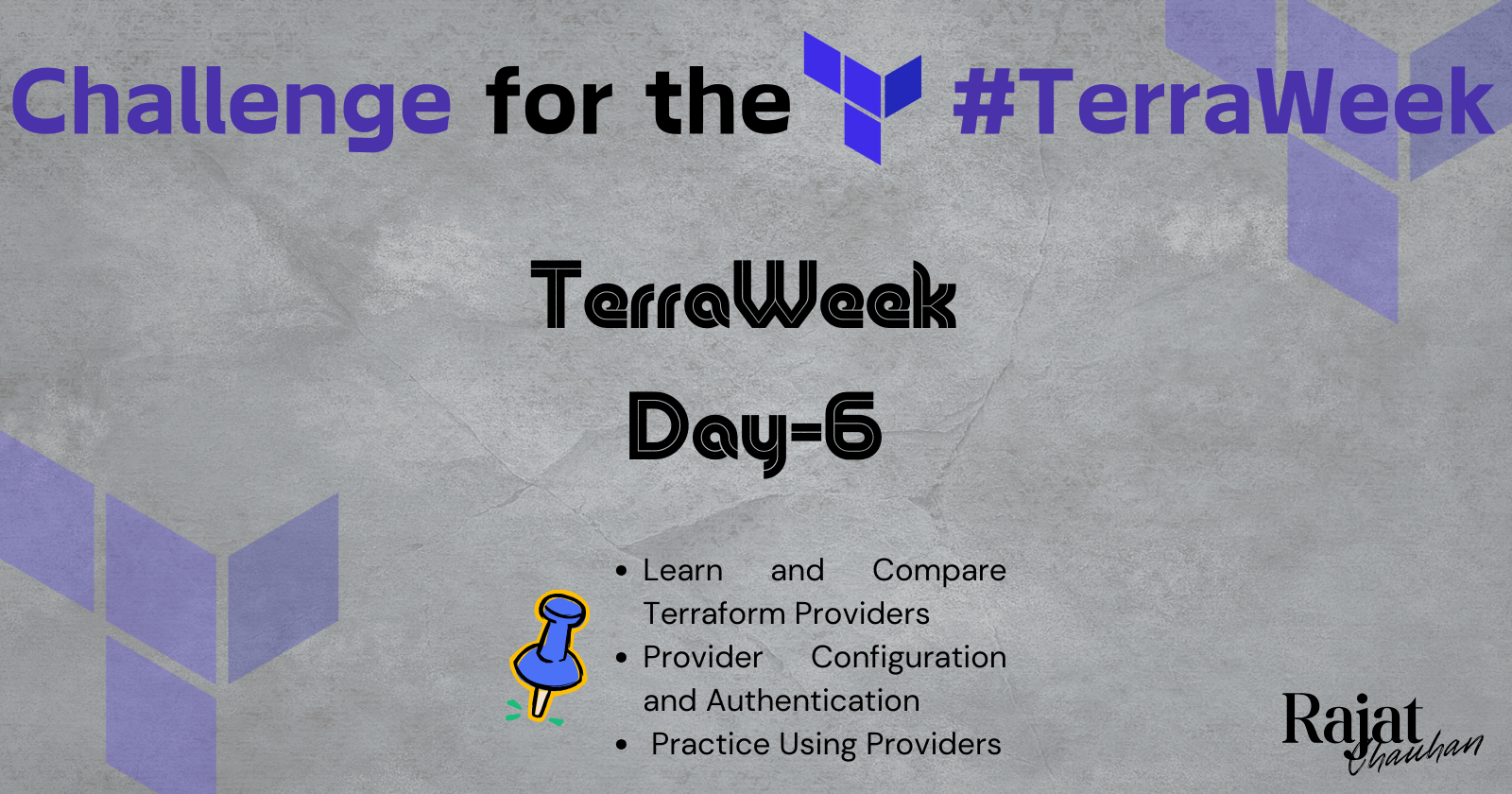Exploring Terraform Providers: Configuration, Authentication, and Practical Application
 Rajat Chauhan
Rajat Chauhan
Introduction
As we dive into Day 6 of the TerraWeek challenge, our focus shifts to the heart of Terraform's infrastructure-as-code capabilities: providers. Terraform providers serve as the bridge between Terraform and the cloud platforms or infrastructure services you wish to manage. In this blog, we will explore the significance of Terraform providers, compare their features across different cloud platforms, delve into provider configuration and authentication, and practice deploying resources using a chosen provider.
Task 1: Understanding and Comparing Terraform Providers
What are Terraform Providers?
Terraform providers are plugins that enable Terraform to interact with APIs of cloud platforms or other infrastructure services. Each provider is responsible for managing resources on a specific platform, such as AWS, Azure, Google Cloud, Kubernetes, etc. Providers define the resources and data sources available for use within a Terraform configuration.
Why are Providers Important?
Providers play a crucial role in Terraform’s ability to be a versatile and powerful tool for infrastructure management. They allow Terraform to manage a wide range of resources, from cloud infrastructure like virtual machines, storage, and networks, to SaaS products, DNS providers, and even monitoring services.
Comparing Providers Across Cloud Platforms
When comparing providers across cloud platforms, it's essential to understand the supported resources and features each provider offers. Here’s a brief comparison of the major cloud platforms:
AWS Provider: Supports a wide array of resources such as EC2 instances, S3 buckets, VPCs, IAM roles, and more. AWS’s Terraform provider is one of the most comprehensive, given the vast number of services AWS offers.
Azure Provider: Provides support for Azure resources like Virtual Machines, Resource Groups, Azure Functions, and more. Azure’s provider is robust and integrates well with the various services offered by Microsoft Azure.
Google Cloud Provider: Manages resources on Google Cloud Platform, including Compute Engine instances, Cloud Storage, VPCs, and BigQuery datasets. Google Cloud’s provider is known for its simplicity and effectiveness in managing GCP resources.
Task 2: Provider Configuration and Authentication
Provider Configuration
To start using a Terraform provider, you need to configure it within your main.tf file. Configuration usually involves specifying the provider and, optionally, the region or any other settings specific to the provider.
Example of configuring the AWS provider:
provider "aws" {
region = "us-west-2"
}
Authentication Mechanisms
Each provider requires authentication to interact with the cloud platform securely. The authentication methods vary depending on the provider:
AWS: Typically authenticated using Access Key ID and Secret Access Key, which can be specified in the
main.tffile, environment variables, or shared credentials file.Example:
provider "aws" { region = "us-west-2" access_key = "your-access-key-id" secret_key = "your-secret-access-key" }Azure: Uses a service principal with a Client ID, Client Secret, Subscription ID, and Tenant ID for authentication.
Example:
provider "azurerm" { features = {} subscription_id = "your-subscription-id" client_id = "your-client-id" client_secret = "your-client-secret" tenant_id = "your-tenant-id" }Google Cloud: Typically authenticated using a service account JSON key file, which can be specified directly in the
main.tffile or by setting theGOOGLE_APPLICATION_CREDENTIALSenvironment variable.Example:
provider "google" { credentials = file("path/to/your/service-account-key.json") project = "your-project-id" region = "us-central1" }
Task 3: Hands-On Practice Using Providers
For this practical task, let's focus on deploying a simple resource using the AWS provider.
Step 1: Configure the AWS Provider
Start by configuring the AWS provider in your main.tf file:
provider "aws" {
region = "us-west-2"
}
Step 2: Authenticate with AWS
Ensure that your AWS credentials are set up either in the Terraform configuration or through environment variables.
Step 3: Create a Simple Resource
Let’s create a Virtual Private Cloud (VPC) using Terraform:
resource "aws_vpc" "main" {
cidr_block = "10.0.0.0/16"
tags = {
Name = "MyVPC"
}
}
Step 4: Apply the Configuration
Initialize Terraform and apply the configuration:
terraform init
terraform apply
Terraform will provision the VPC on AWS. You can check your AWS Management Console to confirm that the VPC has been created.
Step 5: Update and Experiment
You can experiment by updating the cidr_block or adding more resources, such as subnets or route tables, to the configuration file. After making changes, run terraform apply again to observe how Terraform manages the updates.
Step 6: Clean Up
Once you're done experimenting, you can clean up the resources by running:
terraform destroy
This will remove all resources that were created by Terraform.
Conclusion
Day 6 of TerraWeek provided a deep dive into Terraform providers, essential for interacting with various cloud platforms. By understanding provider configuration and authentication, and gaining hands-on experience, you’ve strengthened your ability to manage infrastructure as code using Terraform. Remember to document your learnings and challenges for future reference, as they will be invaluable in mastering Terraform.
Happy Terraforming! 🌍💻
💡 If you need help or have any questions, just leave them in the comments! 📝 I would be happy to answer them!
💡 If you found this post useful, please give it a thumbs up 👍 and consider following for more helpful content. 😊
Thank you for taking the time to read! 💚
Subscribe to my newsletter
Read articles from Rajat Chauhan directly inside your inbox. Subscribe to the newsletter, and don't miss out.
Written by

Rajat Chauhan
Rajat Chauhan
Rajat Chauhan is a skilled Devops Engineer, having experience in automating, configuring, deploying releasing and monitoring the applications on cloud environment. • Good experience in areas of DevOps, CI/CD Pipeline, Build and Release management, Hashicorp Terraform, Containerization, AWS, and Linux/Unix Administration. • As a DevOps Engineer, my objective is to strengthen the company’s applications and system features, configure servers and maintain networks to reinforce the company’s technical performance. • Ensure that environment is performing at its optimum level, manage system backups and provide infrastructure support. • Experience working on various DevOps technologies/ tools like GIT, GitHub Actions, Gitlab, Terraform, Ansible, Docker, Kubernetes, Helm, Jenkins, Prometheus and Grafana, and AWS EKS, DevOps, Jenkins. • Positive attitude, strong work ethic, and ability to work in a highly collaborative team environment. • Self-starter, Fast learner, and a Team player with strong interpersonal skills • Developed shell scripts (Bash) for automating day-to-day maintenance tasks on top of that have good python scripting skills. • Proficient in communication and project management with good experience in resolving issues.